Review Article Phytomedicine:
An ancient approach turning into future potential source of therapeutics
Mukeshwar Pandey , Mousumi Debnath *, Shobit Gupta and Surender K. Chikara, Plant Biotechnology Laboratory, Department of Biotechnology, Jaipur Engineering College and Research Centre , Sitapura, Tonk Road, Jaipur 302022, India. 2Xcelris Labs Ltd, Sydney House, Premchandra Nagar Road, Bodakdev, Ahmadabad 380054, India.
Accepted 25th of March, 2011
Phytomedicine obtained from herbal sources are in great demand in the developed world as they are able to cure many infectious diseases. These plant based drugs provide outstanding contribution to modern therapeutics. The natural medicine are attracting renewed attention from both practical and scientific view points, but the mode of action of folk herbal medicines and related products from nature is even more complex than mechanistic clarification of a single bioactive factor. They have proved their efficacy for primary health care because of their safety and lesser side effects. They also offer therapeutics for age[1]related disorders like memory loss, osteoporosis, immune disorders, etc. The new-found popularity is due to their almost miraculous success with cases which were given up as hopeless by the allopathic doctors as their side-effect free treatment. The integration of phytomedicine into the health system should be developed in such a way to bring harmony between the traditional and modern system of health care with minimum threat to each other. The present review deals with impact and present scenario of phytomedicine in the society. Key words: Phytomedicine, herbal medicine, medicinal plant, metabolomics.
INTRODUCTION Plants are important sources of medicines and presently about 25% of pharmaceutical prescriptions in the United States contain at least one plant-derived ingredient. In the last century, roughly 121 pharmaceutical products were formulated based on the traditional knowledge obtained from various sources. Plant derived drugs came into use in the modern medicine through the uses of plant material as indigenous cure in folklore or traditional systems of medicine. The world is now moving towards the herbal medicine or phytomedicines that repair and strengthening bodily systems (especially the immune system, which can then properly fight foreign invaders) and help to destroy offending pathogens without toxic side effects. The earliest documentation about the usage of herbal remedies comes from China and dates back to 2800 BC. Today, it has been developed as a separate industry as many people favor herbal medicine over Corresponding author. E-mail: mousumi.debnath@gmail.com. Tel: +91-141-2770274, Fax: +91-141-2770803 synthetic medicine. The ancient record is evidencing their use by Indian, Chinese, Egyptian, Greek, Roman and Syrian dates back to about 5000 years (Table 1). About 500 plants with medicinal use are mentioned in ancient texts and around 800 plants have been used in indigenous systems of medicine. Indian subcontinent is a vast repository of medicinal plants that are used in traditional medical treatments (Chopra et al., 1956), which also forms a rich source of knowledge. The various indigenous systems such as Siddha, Ayurveda, Unani and Allopathy use several plant species to treat different ailments (Rabe and Staden, 1997). Over 80,000 species of plants are in use throughout the world. In India around 20,000 medicinal plant species have been recorded (Dev, 1997), but more than 500 traditional communities use about 800 plant species for curing different diseases (Kamboj, 2000). Currently 80% of the world population depends on plant-derived medicine for the first line of primary health care for human alleviation because it has no side effects. Several regulatory models for herbal medicines are currently available including prescription drugs, over-the-counter substances, traditional medicines and dietary supplements. Harmonization and Table 1.
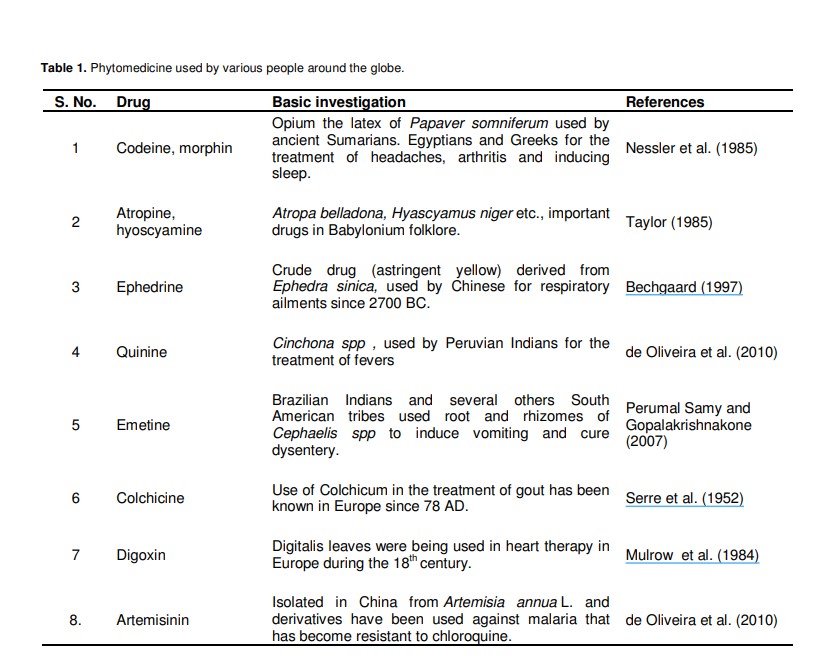
Phytomedicine used by various people around the globe. S. No. Drug Basic investigation References 1 Codeine, morphin Opium the latex of Papaver somniferum used by ancient Sumarians. Egyptians and Greeks for the treatment of headaches, arthritis and inducing sleep. Nessler et al. (1985) 2 Atropine, hyoscyamine Atropa belladona, Hyascyamus niger etc., important drugs in Babylonium folklore. Taylor (1985) 3 Ephedrine Crude drug (astringent yellow) derived from Ephedra sinica, used by Chinese for respiratory ailments since 2700 BC. Bechgaard (1997) 4 Quinine Cinchona spp , used by Peruvian Indians for the treatment of fevers de Oliveira et al. (2010) 5 Emetine Brazilian Indians and several others South American tribes used root and rhizomes of Cephaelis spp to induce vomiting and cure dysentery. Perumal Samy and Gopalakrishnakone (2007) 6 Colchicine Use of Colchicum in the treatment of gout has been known in Europe since 78 AD. Serre et al. (1952) 7 Digoxin Digitalis leaves were being used in heart therapy in Europe during the 18th century. Mulrow et al. (1984) 8. Artemisinin Isolated in China from Artemisia annua L. and derivatives have been used against malaria that has become resistant to chloroquine. de Oliveira et al. (2010) improvement in the processes of regulation is needed, which combines scientific studies and traditional knowledge. Finally, the trend in the domestication, production biotechnological studies and genetic improvement of medicinal plants, instead of the use of plants harvested in the wild, will offer great advantages, since it will be possible to obtain uniform and high quality raw materials which are fundamental to the efficacy and safety of herbal drugs (Calixto, 2000). In this review we discuss the impact of phytomedicine in the present scenario.
PHYTOCHEMICALS: BIOLOGICAL BACKGROUND
All plants produce chemical compounds as part of their normal metabolic activities. These include primary metabolites, such as sugars and fats, found in all plants, and secondary metabolites found in a smaller range of plants, some useful ones found only in a particular genus or species. It is the secondary metabolites and pigments that can have therapeutic actions in humans and which can be refined to produce drugs. These plant based drugs are efficient to work as phytomedicines in the human body. Plants up regulate and down regulate their biochemical paths in response to the local mix of herbivores, pollinators and microorganisms (Baldwin, 2002). The chemical profile of a single plant may vary over time as it reacts to changing conditions. Plants synthesize a bewildering variety of phytochemicals but most are derivatives of a few biochemical motifs. Some of the phytochemicals that can be useful as plant based drugs are discussed.
Alkaloids
Alkaloids contain a ring with nitrogen. Many alkaloids have dramatic effects on the central nervous system.
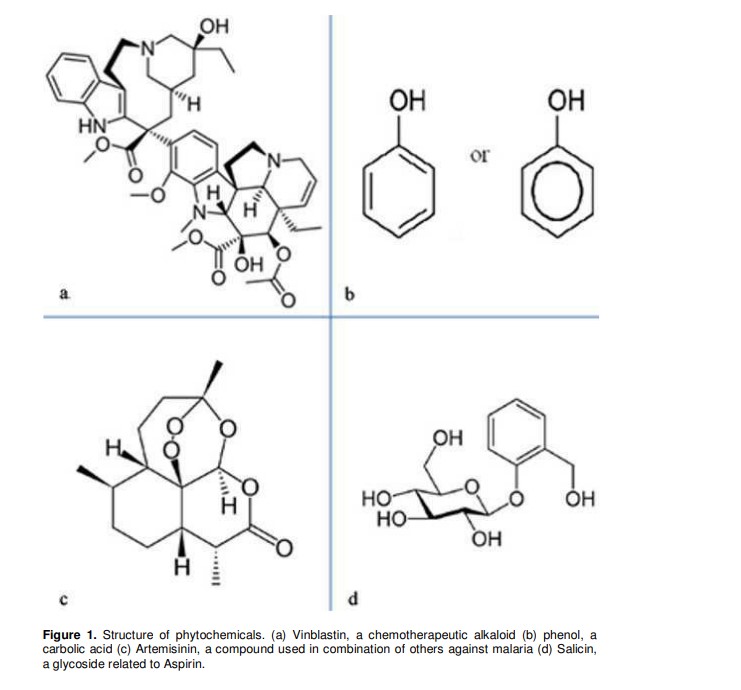
Figure 1. Structure of phytochemicals. (a) Vinblastin, a chemotherapeutic alkaloid (b) phenol, a carbolic acid (c) Artemisinin, a compound used in combination of others against malaria (d) Salicin, a glycoside related to Aspirin. Caffeine is an alkaloid that provides a mild lift but the alkaloids in Datura cause severe intoxication and even death. Some of the alkaloids are hyoscyamine (Datura stramonium), atropine (present in Atropa belladonna, Deadly nightshade), cocaine (present in Erythroxylon coca, the Coca plant), codeine and morphine (present in Papaver somniferum, the opium poppy), tetrodotoxin (a microbial product in Fugu and some salamanders), vincristine and vinblastine (mitotic inhibitors found in the Rosy Periwinkle) (Figure 1a).
Phenols
Phenols are a class of chemical compounds consisting of a hydroxyl group (-OH) bonded directly to an aromatic hydrocarbon group. The simplest of the class is phenol (C6H5OH). The anthocyanins that give grapes their purple color, the isoflavones, the phytoestrogens from soy and the tannins that give tea its astringency are phenolics (Figure 1b).
Terpenoids
Terpenoids are built up from terpene building blocks. Each terpene consists of two paired isoprenes. The names monoterpenes, sesquiterpenes, diterpenes and triterpenes are based on the number of isoprene units. The fragrance of rose and lavender is due to monoterpenes. The carotenoids produce the reds, yellows and oranges of pumpkin, corn and tomatoes.
Table 2. Some of the important medicinal plant used for the treatment of cancer.
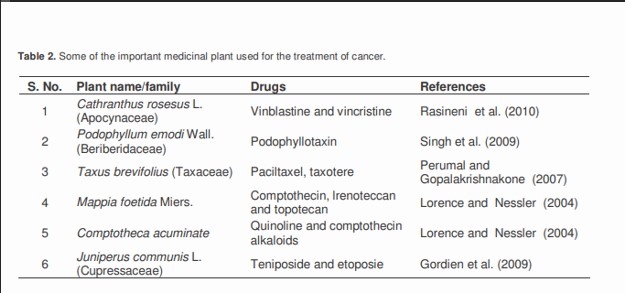
Some of the terpenoids are Azadirachtin, (Neem tree), Artemisinin (Artemisia annua Chinese wormwood), tetrahydrocannabinol (Cannabis sativa), Steroids (Terpenes with a particular ring structure), Saponins (glycosylated steroids) (Figure 1c).
Glycosides
Glycosides consist of a glucose moiety attached to an aglycone. Glycosides are characterized by the glycone, by the type of glycosidic bond, and by the aglycone. Some of the glycosides, by the type of aglycone are alcoholic glycosides, anthraquinone glycosides, coumarin glycosides, cyanogenic glycosides, flavonoid glycosides, phenolic glycosides (simple), saponins, steroidal glycosides or cardiac glycosides, steviol glycosides and thioglycosides (Figure 1d).
PHYTOMEDICINE FROM HIGHER PLANTS
Plant based drugs provide outstanding contribution to modern therapeutics; for example, serpentine isolated from the root of Indian plant Rauwolfia serpentina in 1953, was a revolutionary event in the treatment of hypertension and lowering of blood pressure. During 1950 to 1970 approximately 100 plants based new drugs were introduced in the USA drug market including deserpidine, reseinnamine, reserpine, vinblastine and vincristine which are derived from higher plants. From 1971 to 1990 new drugs such as ectoposide, E[1]guggulsterone, teniposide, nabilone, plaunotol, Z[1]guggulsterone, lectinan, artemisinin and ginkgolides appeared all over the world. 2% of drugs were introduced from 1991 to 1995 including paciltaxel, toptecan, gomishin, irinotecan etc. Vinblastine isolated from the Catharanthus rosesus (Farnsworth et al., 1967) is used for the treatment of Hodgkins, choriocarcinoma, non[1]hodgkins lymphomas, leukemia in children, testicular and neck cancer. Vincristine is recommended for acute lymphocytic leukemia in childhood, advanced stages of Hodgkins, lymophosarcoma, small cell lung, cervical and breast cancer. Podophyllotoxin is a constituent of Podophyllum emodi currently used against testicular, small cell lung cancer and lymphomas. Indian indigenous tree of Nothapodytes nimmoniana (Mappia foetida) are mostly used in Japan for the treatment of cervical cancer (Table 2). Plant derived drugs are used to cure mental illness, skin diseases, tuberculosis, diabetes, jaundice, hypertension and cancer. More than 64 plants have been found to possess significant antibacterial properties; and more than 24 plants have been found to possess antidiabetic properties, antimicrobial studies of plants (Perumal et al., 1998), plant for antiodotes activity – Daboia russellii and Naja kaouthia venom neutralization by lupeol acetate isolated from the root extract of Indian sarsaparilla Hemidesmus indicus R.Br (Chatterjee et al., 2006) which effectively neutralized Daboia russellii venom induced pathophysiological changes (Alam et al., 1994). A large number of formulations are also used these days for curing diseases. Some of the herbal formulations prepared from the plants or plant part used and their role against disease are shown in Table 3.
ROLE OF PHYTOMEDICINE IN HUMAN SOCIETY
People on all continents have used hundreds to thousands of indigenous plants for treatment of ailments since prehistoric times (Levetin and McMahon, 2002). Indigenous healers often claim to have learned by observing that sick animals change their food preferences to nibble at bitter herbs they would normally reject (Huffman, 2003). Lowland gorillas take 90% of their diet from the fruits of Aframomum melegueta, a relative of
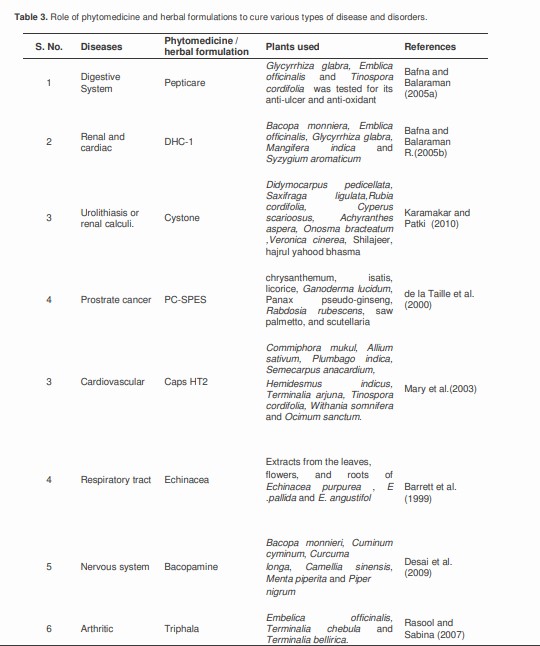
Table 3. Role of phytomedicine and herbal formulations to cure various types of disease and disorders. S. No. Diseases Phytomedicine / herbal formulation Plants used References 1 Digestive System Pepticare Glycyrrhiza glabra, Emblica officinalis and Tinospora cordifolia was tested for its anti-ulcer and anti-oxidant Bafna and Balaraman (2005a) 2 Renal and cardiac DHC-1 Bacopa monniera, Emblica officinalis, Glycyrrhiza glabra, Mangifera indica and Syzygium aromaticum Bafna and Balaraman R.(2005b) 3 Urolithiasis or renal calculi. Cystone Didymocarpus pedicellata, Saxifraga ligulata,Rubia cordifolia, Cyperus scarioosus, Achyranthes aspera, Onosma bracteatum ,Veronica cinerea, Shilajeer, hajrul yahood bhasma Karamakar and Patki (2010) 4 Prostrate cancer PC-SPES chrysanthemum, isatis, licorice, Ganoderma lucidum, Panax pseudo-ginseng, Rabdosia rubescens, saw palmetto, and scutellaria de la Taille et al. (2000) 3 Cardiovascular Caps HT2 Commiphora mukul, Allium sativum, Plumbago indica, Semecarpus anacardium, Hemidesmus indicus, Terminalia arjuna, Tinospora cordifolia, Withania somnifera and Ocimum sanctum. Mary et al.(2003) 4 Respiratory tract Echinacea Extracts from the leaves, flowers, and roots of Echinacea purpurea , E .pallida and E. angustifol Barrett et al. (1999) 5 Nervous system Bacopamine Bacopa monnieri, Cuminum cyminum, Curcuma longa, Camellia sinensis, Menta piperita and Piper nigrum Desai et al. (2009) 6 Arthritic Triphala Embelica officinalis, Terminalia chebula and Terminalia bellirica. Rasool and Sabina (2007) the ginger plant that is a potent antimicrobial and apparently keeps shigellosis and similar infections at bay Sick animals tend to forage plants rich in secondary metabolites, such as tannins and alkaloids (Hutchings et (Engel, 2002). al., 2003). Since these phytochemicals often have antiviral, antibacterial, antifungal and antihelminthic properties, a plausible case can be made for self[1]medication by animals in the wild (Engel, 2002). A plant that is harmless to a particular animal may not be safe for humans to ingest (Denney and Gardener, 2003). A reasonable conjecture is that these discoveries were traditionally collected by the medicine people of indigenous tribes, who then passed on safety information and cautions. During the 1960s, for the first time, Red Lapacho (Tabebuia impetiginosa, syn. Tabebuia avellanedae) attracted considerable attention in Brazil and Argentina as a ‘wonder drug’. Two main bioactive components have been isolated from T. impetiginos: lapachol and beta[1]lapachone. Beta-lapachone is considered to be the main anti-tumour compound, and pro-apoptotic effects were observed in vitro (Castellanos et al., 2009). Many of the pharmaceuticals currently available to physicians have a long history of use as herbal remedies, including opium, aspirin, digitalis, and quinine. The World Health Organization (WHO) estimates that 80% of the world’s population presently uses herbal medicine for some aspect of primary health care. Herbal medicine is a major component in all traditional medicine systems, and a common element in Ayurvedic, homeopathic, naturopathic, traditional Chinese medicine, and Native American medicine.
ECONOMIC BENEFITS AND ROLE OF PRIVATE SECTOR IN PHYTOMEDICINE
The interest in natural therapies has increased international trade and attracted most pharmaceutical companies interested in commercializing phytomedicine (Okigbo and Mmeka, 2006). The private sector plays a crucial role in developing economic activities relating to herbal bioprospecting, using the skills and knowledge of local peoples and compensating them for their knowledge. In both developing and developed countries, traditional medicine plays a significant role in primary care and is often part of the “informal” private sector. In the last few years developing countries have felt the increasing pressure of what has now become known as bioprospecting and biopiracy. The pressure has come especially in the sector of traditional medicine. In parts of Asia and Africa, 80% of the population report frequent use of traditional medicine. In developed countries, nearly 80% have used traditional medicine services. Herbal medicine, a form of traditional medicine, is a billion dollar industry. Policies for traditional medicine exist in over 100 countries, but regulating quality and safety for patient use and sustaining knowledge and resources remain challenges (WHO, 2008). Given the fact that in most countries, very little legislation is in place, civil society groups and governments have reacted increasingly strongly. The production, processing and sale of phytomedicine products create employment for the producing countries (Gunasena and Hughes, 2000). Communities are looking for concrete short term benefits and, in most cases, monetary benefits. Therefore, they would not be interested in long drawn out access and benefit agreements. There is a need for funding agencies and bioprospectors to start funding the communities or the service providers to communities to work through the process of value addition to both potential and existing products, through a bottom up approach.
PHYTOMEDICINE: ROLE OF WORLD HEALTH ORGANIZATION
The World Health Organization (WHO) estimates that 4 billion people, 80% of the world population, presently use herbal medicine for some aspect of primary health care. On the increasing trend in the use of herbal preparations as remedies for major diseases, there is also a growing concern about their efficacy, safety and control. This prompted the WHO to come out with recommendations for control in the document “Research Guidelines for Evaluating the Safety and Efficacy of Herbal Medicines” in 1993. The guidelines are equal in strictness to those applicable for drugs in general (Simaan,2009). Traditional, complementary and alternative medicine (TCAM) has for the last 30 years been recognized by the WHO as providing culturally acceptable, affordable and sustainable primary healthcare (Hollenberg et al., 2008). WHO has hosted interregional workshops to address methodologies for the selection and use of traditional medicines in national primary health care (PHC) programs. WHO, the International Union for the Conservation of Nature and Natural Resources, and the World Wide Fund for Nature developed guidelines for conservation of medicinal plants. Their prolonged strategy includes prevention of the disappearance of forests and associated species and the establishment of botanical gardens. WHO’s Traditional Medicine Programme hopes that people will apply known and effective agro industrial technologies to the cultivation and processing of medicinal plants and the production of herbal medicines for the creation of large-scale networks for the distribution of seeds and plants (Akerele, 1993). WHO notes that of 119 plant-derived pharmaceutical medicines, about 74% are used in modern medicine in ways that correlated directly with their traditional uses as plant medicines by native cultures. Major pharmaceutical companies are currently conducting extensive research on plant materials gathered from the rain forests and other places for their potential medicinal value. In 1991, WHO developed guidelines for the assessment of herbal medicine, and the 6th International Conference of Drug Regulatory Authorities held at Ottawa in the same year ratified the same.
METABOLOMICS IN PHYTOMEDICINE RESEARCH
In order to improve the accuracy and consistency of control phytomedicine preparations worldwide, regulatory authorities are requesting research into new analytical methods for the stricter standardization of phytomedicines. Such methods have to be both objective and robust, and should address the reproducibility of the content of the chemical profiles (Wang et al., 2004). Metabolomics has been employed as an innovative way to meet those demands (Sumner et al., 2003). Plant metabolomes are expected to be much more complex than their mammalian counterparts (Fiehn, 2002). The metabolomes of medicinal plants are particularly a valuable natural resource for the evidence based development of new phytotherapeutics and nutraceuticals. Comparative metabolomics platforms are evolving into novel technologies for monitoring disease development, drug metabolism, and chemical toxicology (Shyur and Yang, 2008). A whole range of well known cancer chemotherapeutic drugs are derived from secondary metabolites of the plant, such as paclitaxel (taxol), camptothecin (irinotecan, topotecan), and podophyllotoxins (etoposide, teniposide). The great potential of plant secondary metabolites or natural products to serve as health care products or lead compounds for new drug development have renewed interest in pharmaceutical and nutraceutical research. The use of whole plants or extracts as medicines gave way to the isolation of active compounds, beginning in the early 19th century with the isolation of morphine from opium; however, in the reductionist approach, single active phytocompounds are sometimes barely able to be identified because of their low abundance in plants, or a spectrum of pharmacological efficacy traditionally observed arises only as a synergistic action of multiple ingredients in a single plant or from a multiple medicinal plant formulation, as in traditional Chinese medicine (Williamson, 2001). The techniques used are multidisciplinary: for target compound analysis and metabolic profiling, the main techniques are gas chromatography, high-performance liquid chromatography and nuclear magnetic resonance (NMR). Further, metabolomics makes use of several complementary analytic methods; in particular, ‘‘hyphenated’’ techniques of LC/MS, LC/MS and LC/NMR are likely to have increased impact. These approaches rely on chromatographic separations, often coupled with well-developed calibrations for specific analytes. The metabolic fingerprinting analyses crude extracts without any separations step, using NMR, direct injection mass spectrometry (MS) or Fourier transform infrared spectroscopy. Gilroy et al. (2003) employed a comparative metabolomics approach for characterizing candidate phytomedicines from a traditional western herbal remedy, by integrating special plant extract preparation, on-line GC–MS or LC–ESI/MS/MS, and metabolite clustering systems to analyze extracts of the three medicinal Echinacea species that are frequently mislabeled in commercial products, that is, Echinacea purpurea, Echinacea pallida, and Echinacea angustifolia. Hyphenated NMR techniques are also a highly valuable tool for the elucidation of the chemical composition of a complex, bioactive fraction of natural origin (Clarkson et al., 2007). As an alternative to the reductionist approach, plant metabolomics strategies are providing new and important insights for medicinal herb research, linking putative bioactivity with the constituent phytocompounds of herbal medicines (Newman and Cragg, 2007).
EXPERIMENTAL EVIDENCE
Curculigo pilosa is commonly used for herbal prepara[1]tions as a purgative and also in the management and treatment of hernia, infertility and gonorrhea in Southwestern Nigeria. The phytochemicals found in C. pilosa were alkaloids, saponins, tannins, cardenolides and traces of anthraquinones. The ethanol extracts (500 mg/ml) and undiluted essential oil exhibited anticandidal activity while the water extract (1000 mg/ml) was inactive against isolates. The MIC exhibited by the ethanol extract against the tested isolates range between 0.020 and 1.500 mg/ml. Thus, the isolation and identification of the active compounds of C. pilosa can lead to the discovery of anticandidal phytomedicine (Titilayo et al., 2010). Okwu and Ukanwa (2010) isolated and elucidate the structure from ethanolic extract of the leaves of Alchornea cordifolia (Schumach. and Thonn.) Mull. Arg, 5-methyl 4′-propenoxy anthocyanidines 7-O-β-D – diglucopyranoside using NMR spectroscopy in combination with IR and MS spectral data. Antibacterial studies showed that the isolated compound successfully inhibited Pseudomonas aerguinosa, Escherichia coli, Proteus mirabilis, Klebsiella pueumonia and Staphylococcus aureus. This result authenticates the use of the plant in phytomedicine for disease prevention and treatment of infections. In the another report by Amorim et al. (2009), the chemical composition of the essential oil of pitangueira leaves was found to exhibit antinociceptive and hypothermic property and can be used to treat inflammations, rheumatic pain and fever and can be used as hypoglycemic and diuretic. It has been widely used in the cosmetics industry. The chemical composition was evaluated by GC-MS and the main constituent of the oil after isolation was found to be a mixture of atractylone (1) and 3-furanoeudesmene (2). The essential oil, its pentane fraction and the isolated mixture of sesquiterpenes (1 and 2), given orally, significantly inhibited the acetic acid-induced abdominal constrictions, increased the latency time in hot plate test and showed a hypothermic effect. Their results suggest that the furanosesquiterpenes was responsible for the antinociceptive and hypothermic effect. These findings provided additional pharmacological information and may contribute for its use as a phytomedicine. Ginkgo biloba extract (GBE) is an ancient Chinese phytomedicine which was used to treat various ailments including circulatory and demential disorders. In one of the few published examples, G. biloba has been assessed using an in vitro platelet aggregation test. The ginkgolides are known to be a PAF antagonist, which is one of their mechanisms of anti-inflammatory activity (Miguelez et al., 1996). In another report, GBE was tested for its possible protective effects against mitomycin C (MMC) and cyclophosphamide (CP) induced mutagenicity using the micronucleus test in mouse bone marrow and results suggest that Egb 761 possesses both direct and indirect antimutagenic potential (Vilar et al., 2009). An extract containing valtrate, isovaltrate, valerenone and valerenic acid has been shown to reduce glucose consumption in the brain, although none of these substances does so individually (Holzl, 1997). Of course there may be a minor, highly potent compound responsible for this activity, but given the amount of chemical research which has been carried out on valerian this seems unlikely!
RESEARCH HURDLES IN PHYTOMEDICINE
Natural medicine are attracting renewed attention is encouraging from both practical and scientific view points, the efficacy has proven over the long decades, but the mode of action of folk herbal medicines and related products from nature is even more complex than mechanistic clarification of a single bioactive factor. This is because unfractionated or partly fractionated extracts are used. Often mixtures of different constituents are present. In any cases synergism is most likely playing an important role. Evaluation and isolation of these mixtures of the active constituent and their mode of action will be the challenging task. Moreover, a potentially far-reaching observation in terms of the safety of consuming certain herbs has been also evaluated. More flexibility will be required of new researchers of natural products than ever before. But because of the new tools available the rewards in terms of interest and the contribution to society will be correspondingly greater than they have ever been previously. There seems little question that a phytomedicine worker will have a role to play for many more years and that pharmacognosits can look to the future with a great deal of anticipation.
PHYTOMEDICINE: MARKET POTENTIALITY
Plant derived drugs are important in Germany and Russia. Particularly, herbal drugs are imported by several countries for their usage of traditional medicinal preparation from various parts of the country.The total sale of phytomedicine shows its popularity and use by people all over the world (Calixto, 2000; Blumenthal, 1999). The European market alone reached $7 billion in 1997; the German market corresponds to about 50% of the European market, about $3.5 billion which represents about $42.90 per capita; the market in France corresponds to about $1.8 billion, Italy follows with $700 million, UK has $400 million, Spain and Netherlands have market sales of $300 million and $100 million respectively (Okigbo and Mmeka, 2006). About 75% of the population of France has used complimentary or alternative medicine at least once (Enwonwu, 2000) and about 60 million of Americans over 18 years uses phytomedicine in the cure of colds, burns, headaches, depression, diarrhea and others (Calixto, 2000). Today almost 40% of all drugs listed in the German Physician’s Desk Reference are derived from plant material. The leading plants prescribed as mono-preparations in Germany are G. biloba, Horse chestnut, Hawthorn, and St. John’s Wort with very high growth rates that are stronger than most of their chemical competitors. Europe has the most developed market in the world in the area of phytomedicines with the best established criteria for licensing and quality control. It can be regarded as a model for other international development (Gruenwald, 1998). In Venezuela, the commerce of medicinal plants presents different strengths and risks, among them stands out as a head corner stone, the diversity of species that enriches and supplies the offer/demand of this market (Baquero et al., 2009). In the United States, the market for medicinal plants soared after the passing of 1994 Dietary Supplements and Health Education Act (DSHEA) that permitted labeling phytomedicine as “dietary supplements” and allowing their sale without the oversight authority of Food and Drug Administration (Singh et al., 2007). China followed by USA, Australia and Indonesia are the highest importers of herbal drugs (Figure 2). In India, the sale of total herbal products is estimated at $ 1 billion and the export of herbal crude extract is about $ 80 million, of which 50% is contributed by Ayurvedic classical preparations (Table 4, Perumal Samy, and Gopalakrishnakone 2007).
CONCLUSION
Phytomedicine, in addition to their traditional values, also hold great public and medical interest worldwide as sources of nutraceuticals or novel lead compounds for drug development. Not only herbal remedy revolution created new opportunities but also served to stimulate research in the field of direct relevance to human health care. The search for active phytocompounds will be greatly advanced by the combination of various metabolomics approaches with an array of bioactivity assays in mammalian systems t o differentiate between
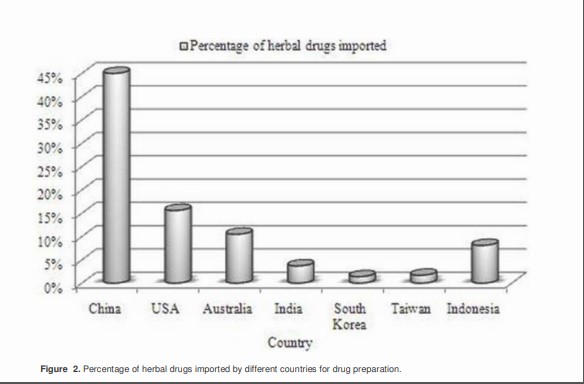
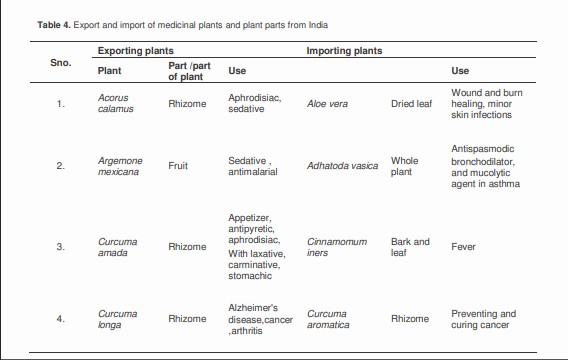
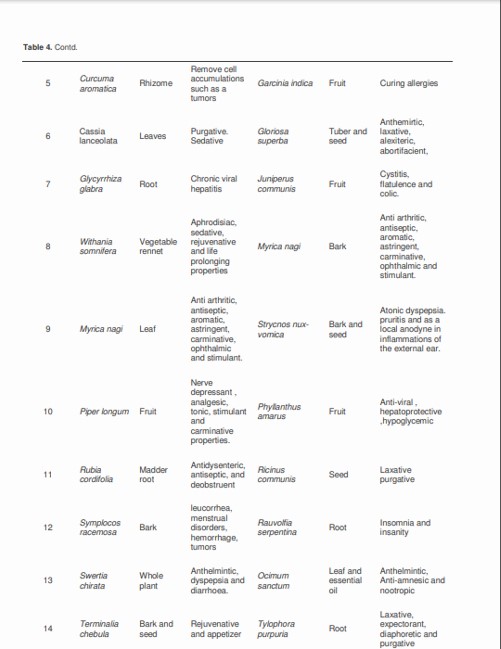

Figure 2. Percentage of herbal drugs imported by different countries for drug preparation. Table 4. Export and import of medicinal plants and plant parts from India Sno. Exporting plants Importing plants Plant Part /part of plant Use Use 1. Acorus calamus Rhizome Aphrodisiac, sedative Aloe vera Dried leaf Wound and burn healing, minor skin infections 2. Argemone mexicana Fruit Sedative , antimalarial Adhatoda vasica Whole plant Antispasmodic bronchodilator, and mucolytic agent in asthma 3. Curcuma amada Rhizome Appetizer, antipyretic, aphrodisiac, With laxative, carminative, stomachic Cinnamomum iners Bark and leaf Fever 4. Curcuma longa Rhizome Alzheimer’s disease,cancer ,arthritis Curcuma aromatica Rhizome Preventing and curing cancer Table 4. Contd. 5 Curcuma aromatica Rhizome Remove cell accumulations such as a tumors Garcinia indica Fruit Curing allergies 6 Cassia lanceolata Leaves Purgative. Sedative Gloriosa superba Tuber and seed Anthemirtic, laxative, alexiteric, abortifacient, 7 Glycyrrhiza glabra Root Chronic viral hepatitis Juniperus communis Fruit Cystitis, flatulence and colic. 8 Withania somnifera Vegetable rennet Aphrodisiac, sedative, rejuvenative and life prolonging properties Myrica nagi Bark Anti arthritic, antiseptic, aromatic, astringent, carminative, ophthalmic and stimulant. 9 Myrica nagi Leaf Anti arthritic, antiseptic, aromatic, astringent, carminative, ophthalmic and stimulant. Strycnos nux[1]vomica Bark and seed Atonic dyspepsia. pruritis and as a local anodyne in inflammations of the external ear. 10 Piper longum Fruit Nerve depressant , analgesic, tonic, stimulant and carminative properties. Phyllanthus amarus Fruit Anti-viral , hepatoprotective ,hypoglycemic 11 Rubia cordifolia Madder root Antidysenteric, antiseptic, and deobstruent Ricinus communis Seed Laxative purgative 12 Symplocos racemosa Bark leucorrhea, menstrual disorders, hemorrhage, tumors Rauvolfia serpentina Root Insomnia and insanity 13 Swertia chirata Whole plant Anthelmintic, dyspepsia and diarrhoea. Ocimum sanctum Leaf and essential oil Anthelmintic, Anti-amnesic and nootropic 14 Terminalia chebula Bark and seed Rejuvenative and appetizer Tylophora purpuria Root Laxative, expectorant, diaphoretic and purgative Table 4. Contd. 15 Zingiber officinale Rhizome Gastrointestina l benefits and carminative and anti[1]inflammatory properties. Vinca rosea Leaf, seed and stem Sedative, hypotensive, tranquilizer and anti-cancerous Adapted from Perumal and Gopalakrishnakone (2007). plant species, tissues, or phytopreparations, and to identify novel lead compound candidates for future development. In a complementary development, the use of metabolome-refined herbal extracts with other biochemical components in combination, rather than as isolated singly compounds (s), may prove to be very useful as broader and holistic therapeutical or pharmacological agents for a variety of human health care application. The integration of phytomedicine into the health system should be developed in such a way to bring harmony between the traditional and modern system of health care with minimum threat to each other. There may be some who might well demur at what they see as the unchallenging prospect of working on phyto[1]medicines, since much is already known.
ACKNOWLEDGEMENT
The authors acknowledge the support for publication to Xcelris Labs Ltd. REFERENCES Akerele O (1993). Nature’s medicinal bounty: don’t throw it away. World Health Forum. 14: 390-5. Alam MI, Auddy B, Gomes A (1994). Isolation and partial characterization of viper venom inhibiting factor from the root extract of the Indian medicinal plant sarsaparilla (Hemidesmus indicus R.Br.) Toxicon 32: 1551–1557. Amorim ACL, Lima CKF, Hovell AMC, Miranda ALP, Rezende CM (2009). Antinociceptive and hypothermic evaluation of the leaf essential oil and isolated terpenoids from Eugenia uniflora L. (Brazilian Pitanga). Phytomed. 16: 923-928. Bafna PA , Balaraman R (2005a). Anti-ulcer and anti-oxidant activity of Pepticare, a herbomineral formulation. Phytomedicine: Inter. J. Phytother.& Phytopharmaco., 12(4):264-70. Bafna PA, Balaraman R.(2005b). Antioxidant activity of DHC-1, an herbal formulation, in experimentally-induced cardiac and renal damage. Phytother Res. 19(3):216-21. Baldwin IT (2002). Unraveling the function of secondary metabolites. In Taiz, L., Zeiger, E. (IIIrd Eds.) Plant Physiol. Online (Essay 13.1). Sunderland: Sinauer Publisher. Baquero E, Giraldo D, Molina C, Bermudez AJ (2009). Current situation of Medicinal Plants Commerce in Venezuela: Risks and Opportunities. Boletín Latinoamericano y del Caribe de Plantas Medicinales y Aromáticas, 8: 24 – 32. Barrett B, Vohmann M, Calabrese C (1999) Echinacea for Upper Respiratory Infection. J. Fam Pract 48: 628-35. Bechgaard E (1997). Reversibility and clinical relevance of morophological changes after nasal application of ephedrine nasal drops. Intl. J. Pharm. 152(1):67. Blumenthal M (1999). Harvard study estimates consumers spend $5.1billion on herbal products? Herbalgram, 45:68. Calixto JB (2000). Efficacy, safety, quality control,marketing and regulatory guidelines for herbal medicines (phytotherapeutic agents). Braz J of Med. and Biol. Res 33: 179-189 Castellanos GJR, Prieto JM, Heinrich M (2009). Red Lapacho (Tabebuia impetiginosa)-A global ethnopharmacological commodity? J. Ethnopharmacol. 121: 1-13. Chatterjee I, Chakravarty AK, Gomesa A (2006). Daboia russellii and Naja kaouthia venom neutralization by lupeol acetate isolated from the root extract of Indian sarsaparilla Hemidesmus indicus R.Br. J. Ethnopharmacol. 106: 38-43. Chopra RN, Nayar SL, Chopra IC. (1956). In Glossary of Indian medicinal plants, Council of Scientific and Industrial Research, New Delhi 1: 197. Clarkson C, Madikane EV, Hansen SH, Smith PJ, Jaroszewski JW (2007). HPLC–SPE-NMR characterization of sesquiterpenes in an antimycobacterial fraction from Warburgia salutaris. Planta Medica, 73: 578-584. de la Taille A, Hayek OR, Burchardt M, Burchardt T, Katz AE (2000) Role of herbal compounds (PC-SPES) in hormone-refractory prostate cancer: two case reports. J Altern Complement Med. 6(5):449-51. de Oliveira AB, Dolabela MF , Póvoa MM, Santos AM , Varotti FD (2010).Antimalarial activity of ulein and proof of its action on the Plasmodium falciparum digestive vacuole Malar J. 2010; 9(Suppl 2): O9. Denney C, Gardener UCM (2003). Take Time to Identify Toxic Plants to Keep Your Family and Pets Safe. Cooperative Extension[1]Tulare/Kings Counties. A newspaper article, University of California. Desai S, Korgaonkar D, Gadre P.,Ghogare A (2009). Effect of Bacopamine, a polyherbal formulation on learning and memory .J of Herbal Med. and Toxicol. 3 (1):31-36 Dev S (1997). Ethnotherapeutic and modern drug development: The potential of Ayurveda. Current Sci. 73: 909-928. Engel C (2002). Wild Health: How Animals Keep Themselves Well and What We Can Learn From Them. By Houghton Mifflin(Ed), Boston. New York. p. 276. Enwonwu CO (2003). Global Trends in the use of complementary medicine. Proceedings of the 2nd Dr. David Barmes’ memorial Heath Symposium, 25th. March, organized by the Regional Center for Oral heath Research and Training for Africa. Jos (Nigeria) in collaboration with WHO Regional Office, Brazzaville. Farnsworth NR, Blowster RN, Darmratoski D, Meer WA, Cammarato LV (1967). Studies on Catharanthus alkaloids IV Evaluation by means of TLC and ceric ammonium sulphate spray reagent. Lloydia 27: 302- 314. Fiehn O (2002). Metabolomics — the link between genotypes and phenotypes. Plant Mol. Biol. 48:155-171. Gilroy CM, Steiner JF, Byers T, Shapiro H, Georgian W (2003). Echinacea and truth in labeling. Arch Internal Med. 163: 699-704. Gordien AY, Gray AI, Franzblau SG, Seidel V( 2009)Antimycobacterial terpenoids from Juniperus communis L. (Cuppressaceae).J Ethnopharmacol. 126(3):500-5. Grunewald J (1998). Herbal Tradition and Pharmaceutical Savvy-One View of the 21st Century Herbal Products Industry. The APHA Report, 2: 14-15. Gunasena HPM , Hughes A (2000). Food for the future 1 Tamarind (Tamarindus indica L.). International Centre for Underutilized Crops, Southampton, U.K, 171 p. Hollenberg D, Zakus D, Cook T, Xu XW (2008). Re-positioning the role of traditional, complementary and alternative medicine as essential health knowledge in global health: do they still have a role to play? World Health Population 10: 62-75. Holzl J (1997). The pharmacology and therapeutics of Valeriana. In Houghton PJ, Hardman R (Eds.), Medicinal and Aromatic Plants – Industrial Profiles. Harwood Academic Publishers. Netherlands, pp. 55-75 Huffman MA (2003). Animal self-medication and ethno-medicine: exploration and exploitation of the medicinal properties of plants. Proceed. Nutr. Society 6: 371-81. Hutchings MR, Athanasiadou S, Kyriazakis I, Gordon IJ (2003). Can animals use foraging behavior to combat parasites? Proceed. Nutr. Society 62: 361-370. Kamboj VP (2000). Herbal medicine. Current Sci. 78: 35-39. Karamakar D, Patki P (2010). Evaluation of efficacy and safety of a herbal formulation Cystone in the management of urolithiasis: Meta[1]analysis of 50 clinical studies. The Internet. J. Alter. Med., 8 (1): 1-18 Levetin, E, McMahon K. (2002). Plants and Society. McGraw Hill Higher Edu., New York, p. 508. Lorence A, Nessler CL. (2004). Camptothecin, over four decades of surprising findings. Phytochemistry. 65(20):2735-49 Mary NK, Babu BH, Padikkala J (2003). Antiatherogenic effect of Caps HT2, a herbal Ayurvedic medicine formulation. Phytomedicine.10(6- 7):474-82 Miguelez R, Palacios I, Navarro F, Gutierrez S, Sanchez-Pernaute O, Egido J, Gonzalez, Eva Herrero-Beaumont G (1996). Anti[1]inflammatory effect of a PAF receptor antagonist and a new molecule with antiproteinase activity in an experimental model of acute urate crystal arthritis. J. Lipid Mediat. Cell Signal. 13: 35-49 Mulrow CD, Feussner JR, Velez R (1984) Reevaluation of digitalis efficacy. New light on an old leaf. Ann Intern Med. 101(1):113-7. Nessler CL, Allen RD, Galewsky S (1985). Identification and characterization of latex-specific proteins in opium poppy Plant Physiol. 79(2):499-504 Newman DJ, Cragg GM (2007). Natural products as sources of new drugs over the last 25 years. J. Nat. Prod. 70: 461-477. Okigbo RN , Mmeka EC (2006).An appraisal of phytomedicine in Africa KMITL Sci. Tech. J. 6( 2) Okwu DE, Ukanwa N (2010). Isolation, characterization and antibacterial activity screening of anthocyanidine glycosides from Alchornea cordifolia (Schumach. and Thonn.) Mull. Arg. Leaves. E-J. Chem. 7: 41-48. Perumal Samy,R. and Gopalakrishnakone P. (2007) Current status of herbal and their future perspectives. Nature Preceding : hdl:10101/npre.2007.1176.1 : Posted 28 Sep 2007 Perumal SR, Ignacimuthu S, Sen H (1998). Screening of 34 Indian medicinal plants for antibacterial properties. J. Ethnopharmacol. 62: 173-182. Rabe T, Staden JV (1997). Antibacterial activity of South African plants used for medicinal purposes. J. Ethnopharmacol. 56: 81-87. Rasineni K, Bellamkonda R, Reddy Singareddy S, Desireddy S (2010). Antihyperglycemic activity of Catharanthus roseus leaf powder in streptozotocin-induced diabetic rats. Pharmacology Res. 2(3): 195-201 Rasool M, Sabina EP (2007). Anti-inflammatory effect of the Indian Ayurvedic herbal formulation Triphala on adjuvant-induced arthritis in mice. Phytother Res. 21(9):889-94. Serre H, Mirouze J, Bonnet H.(1952).Colchicum and pituitary-adrenal hormones in the treatment of gout; 15 observations. Rev Rhum Mal Osteoartic. 19(9):718-21. Shyur LF, Yang NS (2008). Metabolomics for phytomedicine research and drug development. Curr. Opin. Chemical Biol. 12: 66-71 Simaan JA (2009). Herbal medicine, what physicians need to know. The Lebanese Med. J. 57: 215-7. Singh HP, Singh BP, Gulia SK (2007). Research and application imperatives for the sustainable production of phytomedicines. International Symposium on Medicinal and Nutraceutical Plants, Macon, Georgia, USA Singh PK, Kumar R, Sharma A, Arora R, Chawla R, Jain SK, Sharma RK (2009). Podophyllum hexandrum fraction (REC-2006) shows higher radioprotective efficacy in the p53-carrying hepatoma cell line: a role of cell cycle regulatory proteins. Integr Cancer Ther. 8(3):261- 72. Sumner LW, Mendes P, Dixon R (2003). Plant metabolomics: large[1]scale phytochemistry in the functional genomics era. Phytochem. 62: 817-836. Taylor N (1965). Plant Drugs that changes the world .George Allen and Unwin ,London Titilayo GI, Adeyemi E (2010). Phytochemical screening and in vitro anticandidal activity of extracts and essential oil of Curculigo pilosa (Schum and Thonn) Engl. Hypoxidaceae. Afr. J. Biotechnol. 9: 1236-1240. Vilar JB, Leite KR, Chen L (2009). Antimutagenicity protection of Ginkgo biloba extract (Egb 761) against mitomycin C and cyclophosphamide in mouse bone marrow. Genet. Mol. Res. 8: 328-333 Wang Y, Tang H, Nicholson JK, Hylands PJ, Sampson J, Whitcombe I, Stewart CG, Caiger S, Oru I, Holmes E (2004). Metabolomic strategy for the classification and quality control of phytomedicine: A case study of chamomile flower (Matricaria recutita L.) Planta Med. 70: 250-255. Williamson (2001). EM: Synergy and other interactions in phytomedicines. Phytomed. 8: 401-409. World Health Organization.(2008) Fact sheet: traditional medicine. Geneva: World Health Organization
